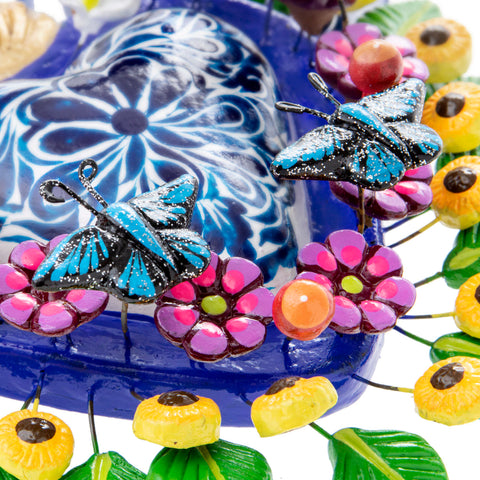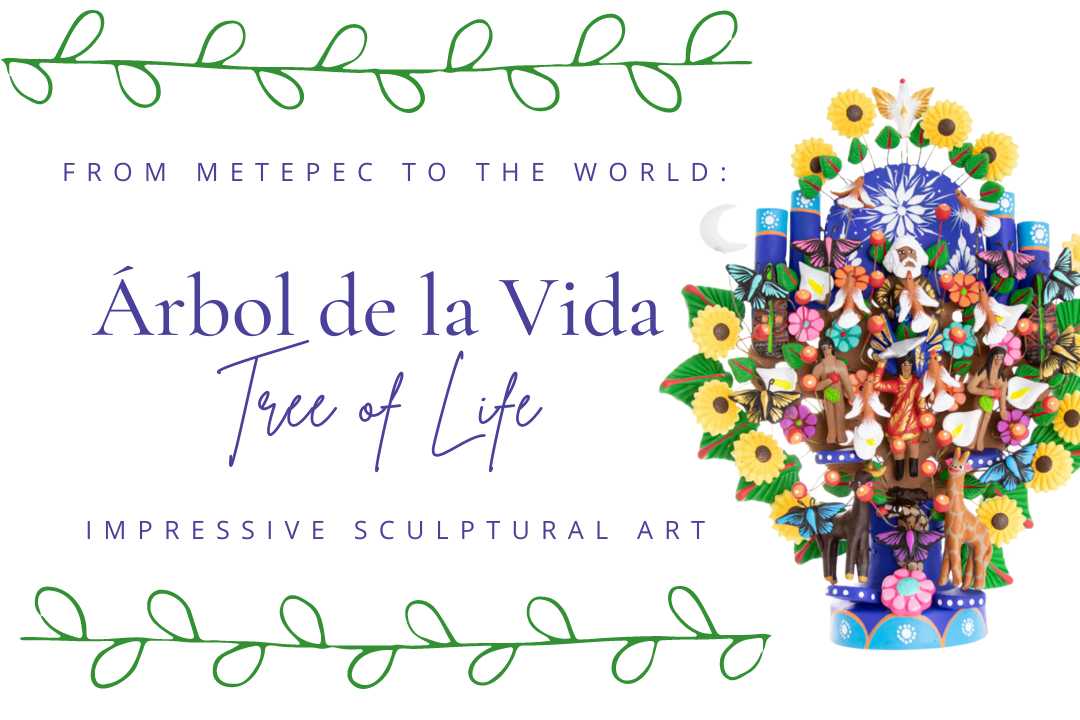Artisans in the State of Mexico create an outstanding work of art filled with historical value and details. We are talking about the impressive Árboles de la Vida, translated as Tree of Life. Árboles de la Vida are one of the most famous sculptures of Mexican culture that traditionally represent the biblical scene of creation. However, over the years, creativity has allowed artisans to incorporate other impressive themes to their art.
Trees of life are a characteristic tradition of the town of Metepec, in the State of Mexico, where the tradition has been passed down from generations and largely spread, producing great artists who give life to masterful and unique sculptures with their hands. Due to their importance to Mexican culture, today we want to tell you all about the origin and meaning of these imposing sculptures.
What is an Árbol de la Vida?
The manufacturing of these clay tree sculptures with the biblical theme of the Garden of Eden in fact, began in Izúcar de Matamoros, Puebla. However, its production later spread to other areas, particularly to the town of Metepec, in the State of Mexico, where the trees of life have come to be considered emblematic of and are now part of a tradition unique to that place.
Metepec artisans use clay working techniques dating back to pre-Hispanic times to make the trees. With the arrival of the Spanish and evangelization, a part of the cultural heritage of the indigenous people was destroyed. From then on, pottery work in the region focused on characters from the Catholic tradition. However, it received ornamental aspects typical of the original indigenous traditions.
What do Árboles de la Vida symbolize?
In its beginnings, the Tree of Life arose as the representation of the biblical scene of Genesis. This is how in each of these pieces we can find images of the Garden of Eden, with Adam and Eve in the center, separated by the tree trunk, and the figure of God looking at them from the top. The serpent from the biblical story also appears, usually at the bottom, as does the Archangel Michael. Other characteristic images found are tree branches that refer to the creation of the world in seven days, the sun, the moon, animals, flowers, and fruits that symbolize paradise.
Although there are common themes and archetypes, when each artisan exhibits their piece, they insert their own narrative and explanation; whether it be regarding its distribution of characters, the relationship between the elements used, etc. Like any work of art, artisans embody more abstract ideas, which is why in recent years, they have created pieces that reflect other concepts such as duality, Eva's femininity, Indigeneity, and even the Day of the Dead celebration. It is becoming increasingly common to see artisans leaving the religious nature of these sculptures and creating pieces with other meanings, elements, and themes that reflect their understanding and pride in Mexican culture.
How are Árboles de la Vida made?
To prepare the clay, artisans go to the fields to collect what it is known as plumilla (tulle flower), a type of grass that gives consistency and strengthens the clay. Plumilla is one of the main elements that distinguish this pottery, mainly because its use is a pre-Hispanic technique used for sculptural images in this region.
To make one Árbol de la Vida, artisans use natural ingredients such as clay from deposits of the region, water for modeling and manipulating the clay, and plumilla, which gives consistency and prevents the clay from breaking easily. Subsequently, they begin the assembly of the tree structure, using wires to attach every element to the piece. After shaping it, the piece is left in the sun to eliminate any humidity before finally going into fire or wood oven. Lastly, the artisans patiently paints the piece if they want to add personality to their creation (before paint, artisans would pigment the clay, a process that would take longer).
We can find trees of life of all sizes, varying from 4 inches to 2 feet tall, and can take anywhere from two weeks to three months to create. However, their manufacture can take up to three years for exceptionally larger and intricate pieces.
Traditionally, Árboles de la Vida are a gift for newlywed couples, as it symbolizes fertility. However, it is currently traded as a decorative object without religious purposes, specifically for its complex designs and the artistic and cultural statement they make.
Árbol de la Vida in danger?
The traditional trade is transmitted from generation to generation through the family social organization; since the pottery trade is the home's livelihood, parents teach their children through practice from childhood.
The Tree of Life has become in recent years a benchmark of not only regional but also national and international culture, due to its great skill of its modeling, as well as its decoration and different themes. Unfortunately, the very same popularity it has gained has also caused the art to be at risk, thanks to counterfeiters. That is why it is vital to verify the authenticity of the pieces and ensure the artisans are paid fairly. Other risk factors of this tradition are the lack of interest of the new generations in continuing with the trade and the loss of natural resources of the raw material for the process of elaboration of the clay.
This is why we are proud to present, promote, and broadcast the impressive art that are Árboles de la Vida. If you would like to support Colectivo Genis, who use generational knowledge to create both Árboles de la vida and Árboles de la Vida-inspired sculpture, be sure to check out their pieces here.
If you would like to learn more about Mexican Pottery, be sure to check out our blog post "Hand Painted Pottery: Mexican Art Made Ceramic".
--
So, what do you think? Did you know all of this about Trees of life? Where you familiar with this craft before? Would you like to read more articles like this one? What else would you like for us to highlight about our cultura? Let us know in the comments below!
Also, don't forget to subscribe to our newsletter where we make sure to share this and many more artisanal techniques, artisan's stories, recipes, and content of interest so that you are 24/7 on the loop! We also make sure to give our familia of subscribers exclusive promotions, gifts, first-hand look at all new products and, of course, these articles that we love to write for you all!
We don't like gatekeeping information. If you would like a copy of this article, feel free to reach out to us at info@lolomercadito.com!









2 comments
Regina
Hola, estoy muy interesada en un árbol de la vida en color natural de barro de las siguientes medidas: 55 cms alto x 40 de ancho para un nicho de 7 cms de profundidad. Vivo en la riviera Maya. Les Puedo enviar una foto del nicho. Muchas gracias.
Erika Adame
Hello. How much would an Arbol de la Vida that is about 3.5 feet tall, not painted be?